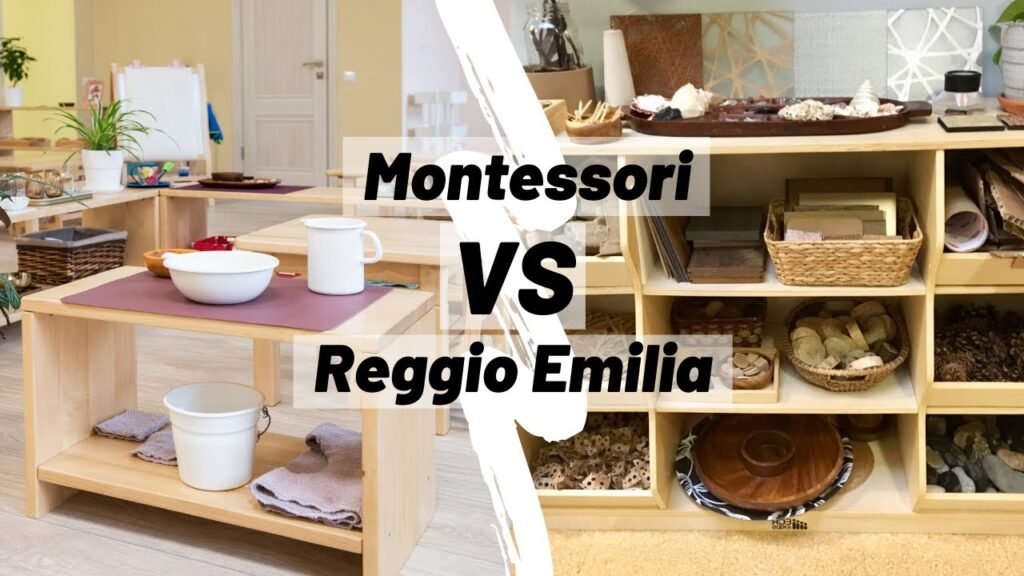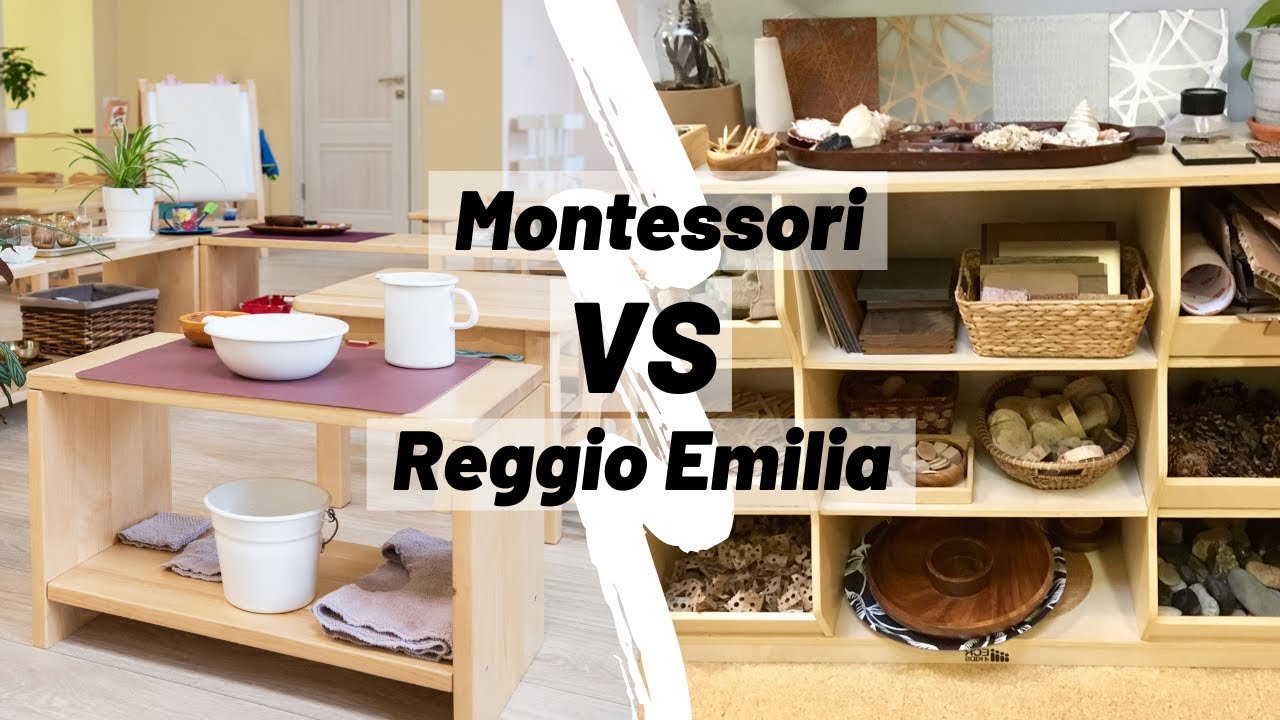Hey there! My name is Ashley and I’m a mom of two little girls, Kylie and Mia. A while back, I made a video comparing the Montessori and Waldorf approaches, and since then, I’ve received numerous requests to explore Montessori versus other educational approaches. One of the most requested is the Reggio Emilia approach. Now, I must admit that I’m not an expert in Reggio Emilia, but I wanted to make sure I provided you with accurate information from credible sources. So, after doing my research, I compiled a list of key similarities and differences between Montessori and Reggio Emilia. In this video, I’ll be sharing the insights I found, focusing on areas such as age groups, classroom grouping, approach to learning, environment, and more. Whether you’re a parent or an educator looking for more information on these approaches, I hope this video helps you navigate the similarities and differences between Montessori and Reggio Emilia. Let’s get started!
In the Montessori approach, the child is viewed as capable, and the adult’s role is more of an observer, making sure the environment is prepared to meet the child’s needs. On the other hand, the Reggio Emilia approach is centered around the child as an active participant in their own learning, with teachers often co-learning and collaborating with the child. Montessori classrooms often have mixed age groups, while Reggio Emilia classrooms typically group children by their chronological age. Additionally, the Montessori approach follows a structured curriculum, while Reggio Emilia emphasizes an emergent curriculum based on the child’s interests and preferences. Both approaches value hands-on learning, natural elements in the environment, and fostering positive relationships among children and the community. If you’re curious to learn more about the similarities and differences between Montessori and Reggio Emilia, stay tuned for the rest of this informative video.

Key Similarities
Constructivist Theories
Both Montessori and Reggio Emilia approaches are based on constructivist theories. This means that both approaches view the child as an active participant in their own learning. They believe that children construct their knowledge through hands-on experiences and interactions with their environment and peers.
Child-Centered Approach
Both Montessori and Reggio Emilia approaches prioritize the child’s individual needs and interests. They recognize that children learn best when they are engaged and interested in the subject matter. Both approaches encourage children to take ownership of their learning and follow their natural curiosity.
Emphasis on Hands-on Learning
Both Montessori and Reggio Emilia approaches value hands-on learning experiences. They believe that children learn best through direct engagement with their environment and materials. They provide children with opportunities to explore, manipulate, and interact with objects and materials to gain a deeper understanding of concepts.
Importance of Positive and Peaceful Relationships
Both Montessori and Reggio Emilia approaches place a strong emphasis on fostering positive and peaceful relationships among children, peers, and the community. They recognize the importance of social and emotional development in children and provide a nurturing environment where children can form meaningful connections with others.
Differences in Age Groups
Montessori Approach
The Montessori approach spans across multiple age groups, from infants to high school students. Maria Montessori initially designed her educational philosophy for preschool-aged children (3-6 years old) but later expanded it to include other age groups. Montessori classrooms often have mixed-age groups, where children learn from and with their peers of different ages.
Reggio Emilia Approach
The Reggio Emilia approach primarily focuses on children aged 0-6 years old. While there are some schools that incorporate the approach up to the middle school level, the primary emphasis is on the early years. Reggio Emilia classrooms typically group children based on their chronological age, with each age group forming a separate class.
Classroom Grouping Differences
Montessori Approach
Montessori classrooms often have mixed-age groups, where children of different ages learn and work together. This promotes collaboration, peer teaching, and learning at each child’s own pace. Older children serve as mentors and role models for younger children, while younger children learn from observing and interacting with older children.
Reggio Emilia Approach
In Reggio Emilia classrooms, children are more commonly grouped together based on their chronological age. Each age group has its own class, where children learn and socialize with peers of the same age. However, there may be some flexibility in grouping, and certain schools may choose to incorporate mixed-age groups.
Approach to Learning
Montessori Approach
The Montessori approach emphasizes independent learning and self-discovery. Children are given the freedom to choose their activities and work at their own pace. The role of the adult is to observe and guide, rather than direct instruction. Montessori classrooms provide a prepared environment with carefully selected materials that promote hands-on learning and exploration.
Reggio Emilia Approach
The Reggio Emilia approach focuses on a collaborative learning process between the child and the adult. Teachers act as co-learners alongside the child, designing activities based on the child’s interests and observations. They ask thought-provoking questions and engage in learning experiences with the child. The curriculum is emergent, meaning it is based on the child’s interests and ideas.
Curriculum Differences
Montessori Approach
The Montessori approach follows a structured curriculum that is divided into different areas of learning, such as practical life, sensorial, language, mathematics, and cultural subjects. The curriculum is designed to provide children with a holistic education, aiming to develop their physical, cognitive, social, and emotional skills. Montessori materials and activities are carefully sequenced and designed to facilitate the child’s learning and progression.
Reggio Emilia Approach
The Reggio Emilia approach does not have a set curriculum. Instead, it follows an emergent curriculum that is based on the child’s interests, experiences, and ideas. Teachers design activities and projects that encourage children to explore and investigate topics of interest. The curriculum is flexible and adaptable, allowing for a more child-directed learning experience.
Environmental Differences
Organization
Montessori classrooms are organized into different areas of learning, with carefully arranged shelves and materials. Each area is designed to focus on a specific aspect of learning, such as practical life, sensorial, or language. The materials are visually appealing and easily accessible to children, promoting independent exploration and learning.
Reggio Emilia classrooms are often referred to as the “third teacher” because of the importance placed on the environment. The classroom is organized to be aesthetically pleasing and inviting, with open spaces and natural lighting. The environment is intentionally arranged to stimulate curiosity, exploration, and creativity.
Use of Natural Elements
Montessori classrooms often incorporate natural materials, such as wooden toys, natural fibers, and plants. The use of natural elements promotes a connection to nature and creates a calm and soothing atmosphere. Children are encouraged to interact with and care for living plants and animals in the classroom.
Reggio Emilia classrooms also make use of natural materials, but their focus goes beyond aesthetics. Natural materials are used to encourage exploration, sensory experiences, and creativity. They are seen as tools for self-expression and symbolic representation.
Inclusion of Provocations and Loose Parts
Montessori classrooms provide children with a variety of hands-on materials that are carefully chosen and organized. The materials are designed to be self-correcting and allow for independent exploration and problem-solving. The focus is on providing children with concrete learning experiences.
Reggio Emilia classrooms incorporate provocations and loose parts into the environment. Provocations are designed to pique children’s curiosity and prompt inquiry. Loose parts refer to open-ended materials that can be used in multiple ways, such as blocks, shells, and fabric. This encourages creativity, imagination, and open-ended exploration.
Emphasis on Arts and Self-Expression
Reggio Emilia Approach
The Reggio Emilia approach places a strong emphasis on the arts and self-expression. Art is seen as a language for children to express their thoughts, feelings, and ideas. Reggio Emilia classrooms provide children with a variety of art materials and tools to explore and create. Artistic experiences are integrated into all areas of the curriculum, promoting creativity and self-discovery.
Montessori Approach
While the Montessori approach also values self-expression, it tends to have a less explicit emphasis on the arts compared to the Reggio Emilia approach. Montessori classrooms do provide art materials and encourage creative expression, but the focus is more on individual exploration and development rather than formal art instruction.
Conclusion
Both Montessori and Reggio Emilia approaches share key similarities, such as constructivist theories, child-centeredness, emphasis on hands-on learning, and importance of positive relationships. However, they also have distinct differences in terms of age groups, classroom grouping, approach to learning, curriculum, and environmental elements. Understanding these differences can help parents and educators make informed choices about which educational approach aligns best with their values and goals for children’s learning and development.

